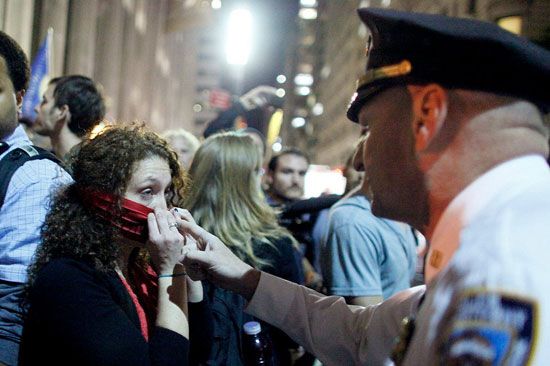Pearl Duncan, “Police Nabs Wall Street Protesters w 1845 Law Banning Masks,” newyork.nearsay.com, September 20, 2011.
In email correspondence with the author on November 25, 2011. Kira Ackerman is an artist and writer based in New Orleans. She has contributed opinion pieces about Occupy Nola to The Lens. See →.
Information about The Language Experiment was obtained by the author in email and Facebook conversations with Peter Rostovsky on November 25, 2011.
For a sample of the sobriquets given both the 1% and the 99% and the evolving coverage of OWS by New York Times columnists, see: Nicholas D. Kristof, “The Bankers and the Revolutionaries,” New York Times, October 1, 2011. See →. Paul Krugman, “Confronting the Malefactors,” New York Times, October 6, 2011. See →. Paul Krugman, “Panic of the Plutocrats,” New York Times, October 9, 2011. See →. David Brooks, “The Milquetoast Radicals,” New York Times, October 10, 2011. See →.
Raoul Vaneigem, The Revolution of Everyday Life (1963), 105. Retrieved on May 14, 2009 from →.
Hakim Bey (Peter Lamborn Wilson), The Temporary Autonomous Zone (New York: Autonomedia, 1991 (1985)). See →.
Aaron Gell, “Occupy Wall Street and the Poetry of Now-Time,” New York Observer, October 21, 2011. See →.
The Invisible Committee, The Coming Insurrection (Los Angeles: Semiotext(e), 2009).
Gavin Grindon, “Carnival Against Capital: A Comparison of Bakhtin, Vaneigem, and Bey,” Anarchist Studies 12:2 (2004): 148. See →.
For a TV broadcast of Stéphane Hessel’s riveting exposition of his convictions, see →.
William Yardley, “The Branding of the Occupy Movement,” New York Times, November 27, 2011. See →.
For the announcement of the People’s Trial see →.
Bennett, ibid.
Claire Tancons, “The Greatest Free Show on Earth: Carnival from Trinidad to Brazil, Cape Town to New Orleans,” Prospect.1 New Orleans, ed. Dan Cameron (Brooklyn: PICTUREBOX, 2009), 60–61. See →.
Claire Tancons, “Spring,” The 7th Gwangju Biennale. Annual Report: A Year in Exhibitions, ed. Okwui Enwezor (Gwangju: The Gwangju Biennale Foundation, 2008), 337. See →.
Nicholas Laughlin, “That is mas,” Rockstone and Bootheel, Contemporary West Indian Art, eds. Yona Backer and Kristina Newman-Scott (Hartford, CT: Real Art Ways, 2010), 22–27. See →.
To read Prime Minister Kamla Persad-Bissessar’s statement on the state of emergency in Trinidad and Tobago,’ see →.
Greg Tate, “Top 10 Reasons Why So Few Blackfolk Appear Down to Occupy Wall Street,” Village Voice, October 19, 2011. See →.
Philip Kasinitz, “New York Equalizes You? Change and Continuity in Brooklyn’s Labor Day Carnival,” Carnival: Culture in Action—The Trinidad Experience, ed. Milla Riggio (New York and London: Routledge, 2004), 273.
The founders of the Brooklyn Jumbies are Najja Codrington, of Bajan and Senegalese descent, and Ali Sylvester, of Trinidadian descent. Barbata has been collaborating with the Brooklyn Jumbies and other stilt-walker groups in Trinidad and Mexico for nearly a decade.
See →.
As emphasized in this YouTube video →.
Email conversation with the author, November 21, 2011.
See “Singing Civil Rights” in T.V. Reed, The Art of Protest: Culture and Activism from the Civil Rights Movement to the Streets of Seattle (Minneapolis and London: University of Minnesota Press, 2005), 1-39.
See →.
In conversation with the author in New Orleans on November 22, 2011.
Information about the November 20 event and mili-tent march provided by Jason Jones in Skype conversations with the author on November 23 and 25, with additional contribution from Beka Economopoulos. Both Jones and Economopoulos are members of Not an Alternative.
For Sen’s views on the question, see the Democracy Now! broadcast of the November 25 Occupy Everywhere panel organized by The Nation →.
All quotes from Eric Bookhardt are from emails exchanged with the author during the night of November 2–3, 2011.
“Occupy Stands Up for the Special Man,” Nola Defender, October 21, 2011.
In an email conversation with the author on November 17, 2011.
“The Cult of Convenience—the Mall on St. Claude,” Nola Anarcha, October 12, 2011. See →.
Max Cafard (John Clark), The Surre(gion)alist Manifesto, circa 1989. See →.
Email conversation with the author on October 17, 2011.
Brendan McCarthy, “About 400 marchers join ‘Occupy New Orleans’ protest,” Times-Picayunes, October 6, 2011. See →.
Jordan Flaherty, Floodlines: Community and Resistance from Katrina to the Jena Six (Chicago: Haymarket Books, 2011), 17-18.
Quoted in Flaherty, ibid., 8.
Bennett, ibid.
Peter Stallybrass and Allon White, The Politics and Poetics of Transgression (Ithaca, New York: Cornell University Press), 1986, p.14.
Bellafante, ibid., September 23. Peter Catapano, “Wall Street Protests: Carnival or Revolution? Can you Hear Them Now?” New York Times, September 30, 2011.
For more on the legacy of J18 see Brian Holmes, “Do-it-Yourself Geopolitics: A Map of the World Upside Down,” Spectacle, Pleasure Principle, or the Carnivalesque? A Reader on Possibilities, Experiences of Difference, and Strategies of the Carnivalesque in Cultural/Political Practice, eds. Sønke Gau and Katharina Schlieben (Berlin: b_books Verlag, 2008), 265-73.
Quoted in Rahul Rao, Third World Protest: Between Home and the World (Oxford: Oxford University Press, 2010), 2.
Michael Hardt and Antonio Negri, Multitude (New York: Penguin Press, 2004), 211.
Mikhail Bakhtin, Rabelais and His World, trans. Helene Iswolsky (Bloomington and Indianapolis: Indiana University Press, 1984), 223.
Claire welcomes your comments on this essay at carnivalagainstcapital@gmail.com as she develops it into a book.
